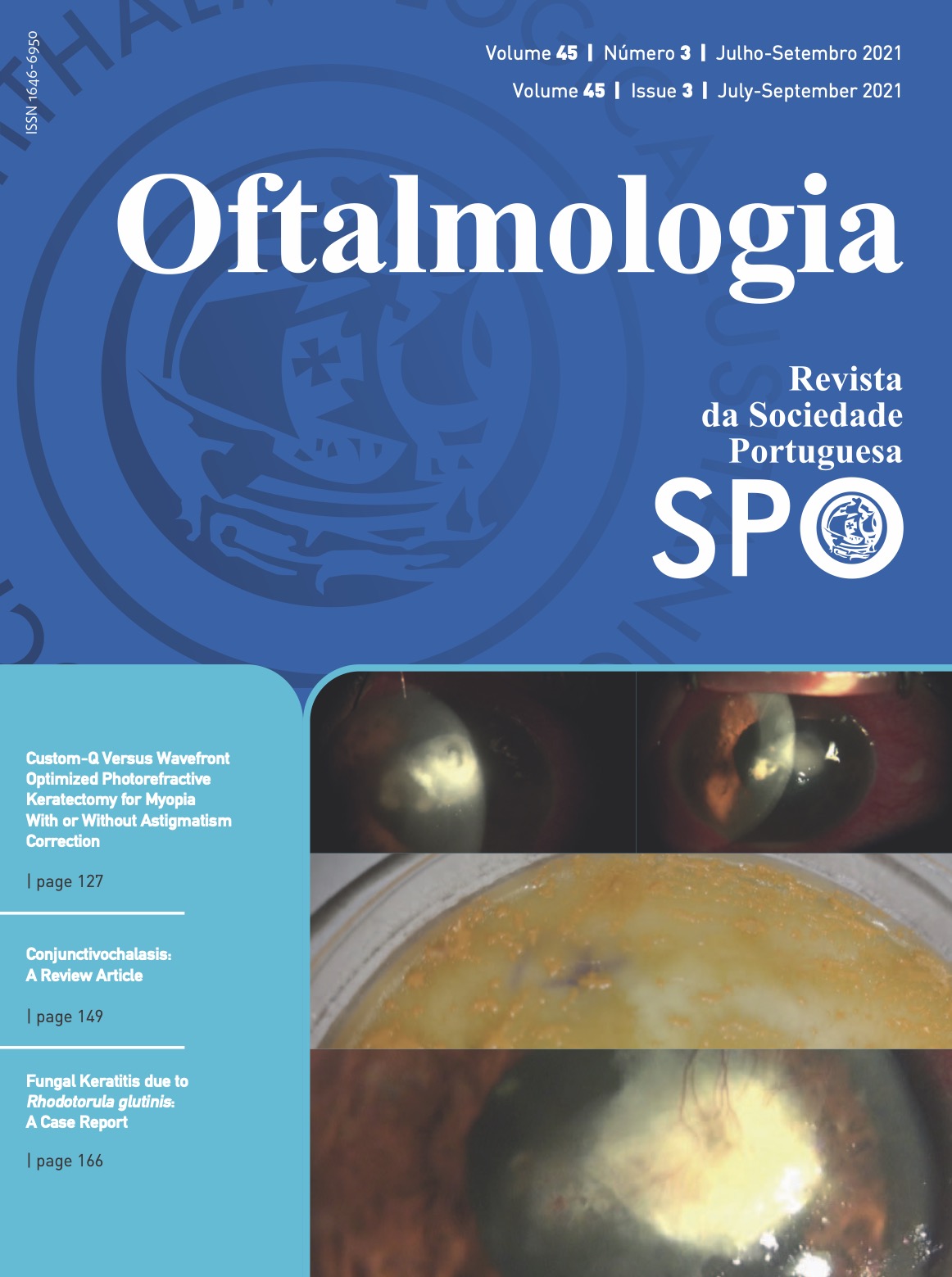Stability of Crosslinking Treatment combined with Excimer Laser for Keratoconus
DOI:
https://doi.org/10.48560/rspo.23896Keywords:
Combined Modality Therapy, Cross-Linking Reagents, Keratoconus, Lasers, Excimer, Photorefractive KeratectomyAbstract
Introduction: The purpose of this study is to evaluate the stability of crosslinking (CXL) treatment associated with photorefractive keratectomy (PRK) with excimer laser in patients with keratoconus, through comparison of keratometric and topographic parameters and functional results at 6 months postoperatively and at the last evaluation.
Methods: Seventy-four eyes of 71 patients with established kerotoconus who had contact lens intolerance and/or disease progression were included. The eyes were submitted to CXL plus partial PRK and a residual stromal thickness of 325 μm in the end of the laser procedure was required. We compared uncorrected visual acuity (UCVA), best-corrected visual acuity (BCVA), refractive sphere and cylinder, keratometric parameters (K1, K2, Kmax, average K) and minimum pachymetry at 6 months and at last evaluation.
Results: The mean age was 32.12±9.73 years. We report the results at 6 months and last evaluation (occurred between 12 and 37 months postoperatively), mean 17.09±6.39 months. All parameters (K1, K2, average K, maximum K, K1 axis, spherical equivalent and minimum pachymetry) remained stable, except for BCVA which improved 0.05 logMAR (p<0.05). No patient lost more than two lines of Snellen chart and the greatest improvement was five lines.
Conclusion: Our results suggest that accelerated CXL with topography-guided PRK in keratoconic eyes resulted in progressive BCVA improvement between 6 months and 12 to 37 months postoperatively. Keratometric and topographic values remained stable postoperatively, confirming the efficacy of the procedure in arresting progression of keratoconus.
Downloads
References
Godefrooij DA, de Wit GA, Uiterwaal CS, Imhof SM, Wisse RL. Age-specific Incidence and Prevalence of Keratoconus: A Nationwide Registration Study. Am J Ophthalmol. 2017;175:169–72. doi: 10.1016/j.ajo.2016.12.015.
Romero-Jiménez M, Santodomingo-Rubido J, Wolffsohn JS. Keratoconus: a review. Cont Lens Anterior Eye. 2010;33:157- 66; quiz 205. doi: 10.1016/j.clae.2010.04.006.
Meek KM, Tuft SJ, Huang Y, Gill PS, Hayes S, Newton RH, et al. Changes in collagen orientation and distribution in keratoconus corneas. Invest Ophthalmol Vis Sci. 2005;46:1948-56. doi: 10.1167/iovs.04-1253.
Rocha G, Vieira BV, Mendes BM, Iguma CI, Silva TC, de Sousa LB, et al. Visual outcomes in advanced keratoco- nus using different strategies: Scleral lens, intracorneal ring segment and lamellar keratoplasty. Eur J Ophthalmol. 2021:1120672121994731. doi: 10.1177/1120672121994731.
Wollensak G, Spoerl E, Seiler T. Riboflavin/ultraviolet-A- induced collagen crosslinking for the treatment of keratoconus. Am J Ophthalmol. 2003;135:620–7. doi: 10.1016/s0002- 9394(02)02220-1.
Spoerl E, Huhle M, Seiler T. Induction of cross-links in corneal tissue. Exp Eye Res. 1998;66:97–103. doi: 10.1006/exer.1997.0410.
Vinciguerra R, Romano MR, Camesasca FI, Azzolini C, Trazza S, Morenghi E, et al. Corneal cross-linking as a treatment for keratoconus: Four-year morphologic and clinical outcomes with respect to patient age. Ophthalmology. 2013;120:908–16. doi: 10.1016/j.ophtha.2012.10.023
Sakla H, Altroudi W, Munoz G, Sakla Y. Simultaneous Topography-Guided Photorefractive Keratectomy and Accelerated Corneal Collagen Cross-Linking for Keratoconus. Cornea. 2016;35:941–5. doi: 10.1097/ICO.0000000000000843.
Kanellopoulos AJ. The impact of keratoconus treatment with the athens protocol (Partial topography-guided photorefractive keratectomy combined with higher-fluence corneal collagen cross-linking) on quality of life: A long-term study. Clin Ophthalmol. 2019;13:789–94. doi: 10.2147/OPTH.S188519.
Kanellopoulos AJ, Asimellis G. Keratoconus management: Long- term stability of topography-guided normalization combined with high-fluence CXL stabilization (the Athens Protocol). J Refract Surg. 2014;30:88–92. doi: 10.3928/1081597X-20140120-03.
Kanellopoulos AJ, Asimellis G. Epithelial remodeling after partial topography-guided normalization and high-fluence short-duration crosslinking (Athens protocol): Results up to 1 year. J Cataract Refract Surg. 2014;40:1597–602. doi: 10.1016/j. jcrs.2014.02.036.
Kamiya K, Ishii R, Shimizu K, Igarashi A. Evaluation of corneal elevation, pachymetry and keratometry in keratoconic eyes with respect to the stage of Amsler-Krumeich classification. Br J Ophthalmol. 2014;98:459–63. doi: 10.1136/bjophthal- mol-2013-304132.
Meiri Z, Keren S, Rosenblatt A, Sarig T, Shenhav L, Varssano D. Efficacy of corneal collagen cross-linking for the treatment of keratoconus: A systematic review and meta-analysis. Cor- nea. 2016;35:417–28. doi: 10.1097/ICO.0000000000000723.
Kontadakis GA, Kankariya VP, Tsoulnaras K, Pallikaris AI, Plaka A, Kymionis GD. Long-Term Comparison of Simultaneous Topography-Guided Photorefractive Keratectomy Followed by Corneal Cross-linking versus Corneal Cross-linking Alone. Ophthalmology. 2016;123:974-83. doi: 10.1016/j.ophtha.2016.01.010.
Asri D, Touboul D, Fournié P, Malet F, Garra C, Gallois A, et al. Corneal collagen crosslinking in progressive keratoconus: Multicenter results from the French National Reference Center for Keratoconus. J Cataract Refract Surg. 2011;37:2137–43. doi: 10.1016/j.jcrs.2011.08.026.
Ahmet S, Agca A, Yaga D, Koç AA, Togaç M, Yildirim Y, et al. Simultaneous transepithelial topography-guided photorefractive keratectomy and accelerated cross-linking in keratoconus: 2-year follow-up. Biomed Res Int. 2018;2018:2945751. doi: 10.1155/2018/2945751.
Huang J, Shen Y, Jian W, Xu H, Li M, Zhao J, et al. Two-year topographic and densitometric outcomes of accelerated (45 mW/cm2) transepithelial corneal cross-linking for keratoconus: A case-control study. BMC Ophthalmol. 2018;18:337.
doi: 10.1186/s12886-018-0999-4.
Wolle MA, Randleman JB, Woodward MA. Complications of refractive surgery: Ectasia after refractive surgery. Int Ophthalmol Clin. 2016;56:127-39. doi: 10.1097/IIO.0000000000000102. 19. Randleman JB, Woodward M, Lynn MJ, Stulting RD. Risk Assessment for Ectasia after Corneal Refractive Surgery. Ophthalmology. 2008;115:37-50. doi:10.1016/j.ophtha.2007.03.073.
Ohana O, Kaiserman I, Domniz Y, Cohen E, Franco O, Sela T, et al. Outcomes of simultaneous photorefractive keratectomy and collagen crosslinking. Can J Ophthalmol. 2018;53:523–8. doi:10.1016/j.jcjo.2017.12.003
Kanellopoulos AJ. Ten-year outcomes of progressive keratoconus management with the Athens protocol (topography-guided partial-refraction PRK combined with CXL). J Refract Surg. 2019;35:478-83. doi: 10.3928/1081597X-20190627-01
Wittig-Silva C, Chan E, Islam FMA, Wu T, Whiting M, Snibson GR. A randomized, controlled trial of corneal collagen crosslinking in progressive keratoconus: Three-year results. Ophthalmology. 2014;121:812–21. doi: 10.1016/j.ophtha.2013.10.028.
Kanellopoulos AJ, Vingopoulos F, Sideri AM. Long-Term Stability with the Athens Protocol (Topography-Guided Partial PRK Combined with Cross-Linking) in Pediatric Patients with Keratoconus.Cornea. 2019;38:1049-57. doi: 10.1097/ ICO.0000000000001996.
Hersh PS, Stulting RD, Muller D, Durrie DS, Rajpal RK; United States Crosslinking Study Group. United States Mul- ticenter Clinical Trial of Corneal Collagen Crosslinking for Keratoconus Treatment. Ophthalmology. 2017;124:1259-70. doi: 10.1016/j.ophtha.2017.03.052.
Iqbal M, Elmassry A, Tawfik A, Elgharieb M, Nagy K, Soliman A, et al. Standard cross-linking versus photorefractive keratectomy combined with accelerated cross-linking for keratoconus management: a comparative study. Acta Ophthalmol. 2019;97:e623-31. doi: 10.1111/aos.13986.
Awwad ST, Chacra LM, Helwe C, Dhaini AR, Telvizian T, Torbey J, et al. Mitomycin C Application After Corneal Cross- linking for Keratoconus Increases Stromal Haze. J Refract Surg. 2021;37:83-90. doi: 10.3928/1081597X-20201124-01.
Ezzeldin M, Filev F, Steinberg J, Frings A. Excimer laser treatment combined with riboflavin ultraviolet-A (UVA) collagen crosslinking (CXL) in keratoconus: a literature review. Int Ophthalmol. 2020;40:2403-12. doi: 10.1007/s10792-020-01394-5.
Koller T, Mrochen M, Seiler T. Complication and failure rates after corneal crosslinking. J Cataract Refract Surg. 2009;35:1358-62. doi: 10.1016/j.jcrs.2009.03.035.
Parker JS, van Dijk K, Melles GR. Treatment options for ad- vanced keratoconus: A review. Surv Ophthalmol. 2015;60:459- 80. doi: 10.1016/j.survophthal.2015.02.004.
Downloads
Published
How to Cite
Issue
Section
License
Copyright (c) 2021 Revista Sociedade Portuguesa de Oftalmologia

This work is licensed under a Creative Commons Attribution-NonCommercial 4.0 International License.
Do not forget to download the Authorship responsibility statement/Authorization for Publication and Conflict of Interest.
The article can only be submitted with these two documents.
To obtain the Authorship responsibility statement/Authorization for Publication file, click here.
To obtain the Conflict of Interest file (ICMJE template), click here





